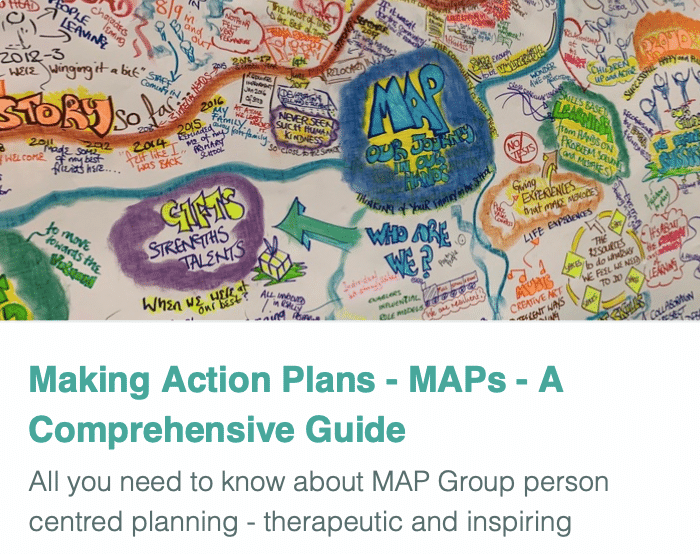
MAP – Making an Action Plan with Person Centred Processes
To facilitate a group, family, team or organisation in thinking together around a given challenge or issue here is an opportunity to experience for real the person centred, futures planning tool – MAP (Pearpoint, Forest et. al. 1989). This is a process not a training day. Let us facilitate your planning and refocus your story whilst strengthening you and your group.
On Line Course now available via Teachable Platform – MAPs – Making Action Plans Learn at your own pace… lots of text and video support  |
Course Category
Person Centred Planning
Strategic Work
Early Years
Inclusion
Description
To facilitate a group, family, team or organisation in thinking together around a given challenge or issue here is an opportunity to experience for real the person centred, futures planning tool – MAP (Pearpoint, Forest et. al. 1989).
This is a process not a training day. Let us facilitate your planning and refocus your story whilst strengthening you and your group.
This tool uses both process and graphic facilitation to help any group develop a shared vision and then to make a start on working out what they will need to do together to move towards that vision.
MAPS are great for threshold moments.
- Is your team stuck?
- Want to move on, haunted by the past cannot get any useful dialogue about the future?
- Facing a challenging transition into a new school or setting?
- Leaving school?
- Bored with annual reviews, transition plans and review meetings?
- Want to find a way of making meetings and planning feel more real and engaging?
- Need an approach, which engages a young person respectfully together with his or her family and friends?
- Want the ultimate visual record of the process of a meeting, which will help everyone, keep track?
- Want to problem solve and plan for the future of a small or large group, service or organisation up to the size of an LEA
You need a MAP!
Testimonials
“Inspired”
“Ready to move on”
“Thanks for the superb day”
Learning Objectives
- To create a shared vision
- To talk through the story so far and reflect upon it
- To name the worse nightmares that will block progress
- To strengthen the group by focussing on gifts and capacity
- To detail needs
- To specify an Action Plan
- To create a visual graphic record of the whole event
Who Is It For ?
- Multi Agency Teams
- Social workers
- CAMHS teams
- Year Managers
- Primary and secondary staff teams
- Early Years and School based Practitioners
- Heads and Deputies
- SENCOs
- Advanced Skills Teachers
- Primary and secondary teachers
- Local Authority Support Services
- Person Centred Planning Facilitators
Course Content
The MAP process has 6 Steps:
- The story so far.
The group is required to think back over the years to describe their collective experience of changes and events over time within their settings. Stories and events are recorded on the graphic. - Building Shared Dreams.
The group thinks together about what they would love to see happening for children, families and practitioners in their settings if they could have it all. If there were no constraints on time, money, resources, people or anything else what do they see happening in their imaginations? The various ideas that the group comes up with are then recorded in key words, images and colours on the MAP graphic. The purpose of this Step is to give the group a sense of direction, their North Star, an image of the place they want to work towards. - Nightmare.
In this Step, the group imagines the worst scenarios. What is the opposite of their dreams? How bad could it get? This is a shorter but powerful process that can give some groups more energy than dreaming together. - Gifts and Capacity.
In this Step the group is asked to take explicit stock of their capacities and what they already have going for them as they begin working towards the vision. This is a strong reminder for any group of the wealth of knowledge and experience that is already and always in the room. - Needs.
In this Step the group is invited to begin to name some of the needs they will have if they are to move forward to wards the dream and away from the nightmare. - Actions.
This is the final Step in the MAP and calls for individuals within the group to name a range of very specific actions (however small) that they will take within a definite time scale. This is not a time for declaring good intentions or suggesting good ideas for someone else to do. The purpose of this Step is to end the MAP process with a range of clearly understood actions that carry this planning process forward into the real world.
- The story so far.
If you liked this course you may well like:
Trackback from your site.